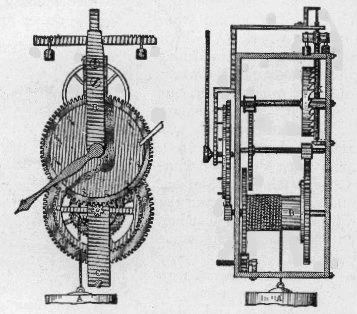 | ||
A turret clock or a public clock is a clock that is larger than a domestic clock and has a mechanism designed to drive a visual time indicator such as dials and or bells as a public amenity. Turret clocks specifically had mechanisms mounted high in a building often a purpose built tower such as churches, town halls, and other public buildings. Clocks were not referred to as turret clocks by clockmakers until recent times, often old clocks were recognised as turret clocks by their location.
Contents
- Water clocks
- Mercury clocks
- Verge and foliot clocks
- Pendulum clocks
- Electrical clocks
- Table of early public turret clocks
- Thirteenth century
- Fourteenth century
- References
A true turret clock has mechanical and latterly electrical power and therefore sits late in the history of timekeeping. The following timeline of clocks is not comprehensive but does indicate the placement of turret clocks.
Water clocks
Water clocks are reported as early as 4000 B.C. In Europe, water clocks were used from around 1000 A.D. to around 1350 A.D.
Mercury clocks
Mercury clocks used a drum with several chambers that were connected through calibrated holes. A rope was wound around the drum with a weight connected to one end. The weight pulling down turned the drum, and the mercury in the drum chambers resisted the turning motion by slowly flowing from one segment of the drum to the next, thus inhibiting the movement of the drum and making it turn at a more or less constant speed. The movement of the drum could be used to measure time.
Verge and foliot clocks
The first all-mechanical clocks which emerged in the 14th century kept time with a verge escapement and foliot. In the second half of the 14th century, over 500 striking turret clocks were installed in public buildings all over Europe. This was the first time public clocks became easy to maintain, as water clocks needed more or less constant attention, so only wealthy institutions with enough manpower could maintain them. The verge and foliot mechanical clocks were relatively easy to maintain and so found their way into many churches, bell towers and town halls. This new technology spread quite fast (within a decade all over Europe).
Pendulum clocks
The fourth generation of clocks were mechanical clocks with a pendulum, which was invented in 1657 by Christiaan Huygens. As the pendulum was more exact than the foliot, some foliot clocks were converted to pendulum. Again, this new technology was adopted quickly throughout Europe, with many clocks being converted (e.g. Castle Combe Clock, Salisbury cathedral clock, ...).
Electrical clocks
Electric turret clocks and hybrid mechanical/electric and were introduced in the late 19th century.
Some mechanical turret clocks are wound by electric motor. These still are considered mechanical clocks.
Table of early public turret clocks
This table shows some of the turret clocks which were installed throughout Europe. It is not complete and mainly serves to illustrate the rate of adoption. There are hardly any surviving turret clock mechanisms that date before 1400, and because of extensive rebuilding of clocks the authenticity of those that do survive is disputed. What little is known of their mechanisms is mostly gleaned from manuscript sources.
The "country" column refers to the present (2012) international boundaries. For example, Colmar was in Germany in 1370, but is now in France.
Thirteenth century
The verge and foliot escapement is thought to have been introduced sometime at the end of the thirteenth century, so very few if any of these clocks had foliot mechanisms; most were water clocks or in a few cases, possibly mercury.
Fourteenth century
During the fourteenth century, the emergence of the foliot replaced the high-maintenance water clocks. It is not known when that happened exactly and which of the early 14th century clocks were water clocks and which ones use a foliot.
The Heinrich von Wieck clock in Paris dating from 1362 is the first clock of which it is known with certainty that it had a foliot and a verge escapement. The fact that there is a sudden increase in the number of recorded turret clock installations points to the fact that these new clocks use verge & foliot. This happens in the years 1350 and onwards.
It becomes apparent that even small towns can afford to put up public striking clocks. Turret clocks are now common throughout Europe.
No surviving clock mechanisms (apart from the claims from Salisbury and Wells) known from this era.
